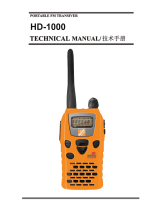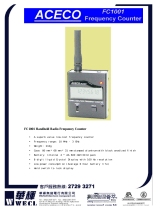
iv
Compliance with RF Exposure Standards
Your Motorola two-way radio is designed and tested to comply with a number of national and
International standards and guidelines (listed below) for human exposure to radio frequency
electromagnetic energy. This radio complies with the IEEE (FCC) and ICNIRP exposure limits for
occupational/controlled RF exposure environments at operating duty factors of up to 50% talk-
50% listen and is authorized by the IEEE/ICNIRP for occupational use only.
In terms of measuring RF energy for compliance with these exposure guidelines, your radio
generates measurable RF energy only while it is transmitting (during talking), not when it is
receiving (listening) or in standby mode.
Note: The approved batteries, supplied with this radio, are rated for a 5-5-90 duty cycle (5% talk–5%
listen–90% standby), even though this radio complies with IEEE/ICNIRP occupational exposure limits
at usage factors of up to 50% talk.
Your Motorola two-way radio complies with the following RF energy exposure standards and
guidelines:
● United States Federal Communications Commission, Code of Federal Regulations; 47 CFR part 2
sub-part J
● American National Standards Institute (ANSI) / Institute of Electrical and Electronic Engineers
(IEEE) C95. 1-1992
● Institute of Electrical and Electronic Engineers (IEEE) C95.1-1999 Edition
● International Commission on Non-Ionizing Radiation Protection (ICNIRP) 1998
● Ministry of Health (Canada) Safety Code 6. Limits of Human Exposure to Radiofrequency
Electromagnetic Fields in the Frequency Range from 3 kHz to 300 GHz, 1999
● Australian Communications Authority Radiocommunications (Electromagnetic Radiation - Human
Exposure) Standard 2003
● ANATEL ANNEX to Resolution No. 303 of July 2, 2002 "Regulation of limitation of exposure to
electrical, magnetic and electromagnetic fields in the radio frequency range between 9 KHz and
300 GHz" and "Attachment to resolution # 303 from July 2, 2002"
RF Exposure Compliance and Control Guidelines and Operating Instructions
To control your exposure and ensure compliance with the occupational/controlled environment expo-
sure limits, always adhere to the following procedures:
Guidelines:
● User awareness instructions should accompany device when transferred to other users.
● Do not use this device if the operational requirements described herein are not met.
Operating Instructions
● Transmit no more than the rated duty factor of 50% of the time. To transmit (talk), push the Push-To-
Talk (PTT) button. To receive calls, release the PTT button.
Transmitting 50% of the time, or less, is important because this radio generates measurable RF
energy exposure only when transmitting (in terms of measuring for standards compliance).
● When worn on the body, always place the radio in a Motorola-approved clip, holder, holster, case,
or body harness for this product. Using approved body-worn accessories is important because the
use of non-Motorola-approved accessories may result in exposure levels, which exceed the IEEE/
ICNIRP occupational/controlled environment RF exposure limits.
● If you are not using a body-worn accessory and are not using the radio in the intended use position,
along side the head in the phone mode (TETRA only), in front of the face in the hand held mode,
then ensure the antenna and the radio are kept 2.5 cm (one inch) from the body when transmitting.
Keeping the radio at a proper distance is important because RF exposures decrease with
increasing distance from the antenna.























